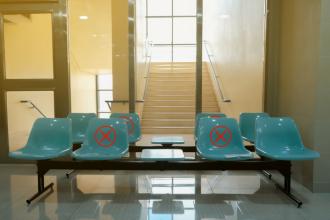Indoor air quality
Indoor air quality in an office environment is meant to be safe and comfortable. The office environment is very different from the industrial setting. Toxic emissions in an office setting are not expected but may occur on rare occasions due to something unusual in the office environment or the entrainment of pollution from outside. Air pollutants may originate from a neighboring industry, somehow bypassing the building’s ventilation system, or they may enter the building due to poor design, such as a ventilation air intake located in a parking lot, resulting in entrainment of car exhaust into the office space.
Many modern office buildings are sealed to the outside with windows that do not open. These buildings rely completely on the ventilation system for healthy indoor air quality. A well-maintained, well-balanced, properly running heating, ventilation, and air conditioning (HVAC) system should provide a cleaner and more comfortable environment than the outdoors. This system filters out most outdoor dust and particulates. It also maintains the temperature and relative humidity within the recommended range for occupant comfort. It provides an adequate mix of recycled and fresh air to minimize heating or cooling costs, while avoiding staleness of the air.
Typically, four parameters are measured when evaluating indoor air quality: temperature, relative humidity, carbon dioxide (CO2) levels, and carbon monoxide (CO) levels (see Box). CO2 is emitted by people working in the office building. An excessive accumulation of CO2 indicates an inadequate amount of fresh air for the number of people in the space. Elevated levels of CO2 commonly correlate with complaints of poor air quality and a multitude of nonspecific health symptoms. This can be corrected simply by increasing the fresh air intake. CO originates from incomplete combustion of organic matter, and common sources include fires, internal combustion engines, furnaces, and cigarette smoke. The occupational exposure limit for CO level is 25 ppm or less. However, in an office building, there should not be any CO in the air. Any level of CO in the ambient air of an office building should be investigated and mitigated.
Acceptable indoor air quality levels
Temperature: 20 to 27 °C
Relative humidity: 30% to 60%
CO2: < 1000 ppm above the outdoor concentration
CO: ≤ 25 ppm (should be 0 ppm)
There are other contaminants that can be found in office buildings, such as emissions from printers, photocopiers, and fax machines. These machines can release ozone and volatile organic compounds (VOC), as well as fine dust. To mitigate the effects of these emissions, fax and photocopy machines can be placed in a separate, enclosed room with higher local ventilation to prevent entrainment of the emissions into the general office environment.
Office furnishings, carpeting, and wall coatings such as paint can also emit VOC through off-gassing. This is typically worse when the furnishings, carpets, and paints are relatively new and gradually diminishes over time. Other emissions may originate from occupants, in the form of body odor or scented personal care products. While these products are not harmful, they can produce many complaints, and a general office policy regarding their use is usually sufficient to eliminate the problem.
Office renovations are also often the source of air-quality complaints from office workers, as the renovations may involve the release of unwanted aerosols in the form of particulates, volatile chemicals, and paint vapors, as well as noise. Many of these contaminants will eventually be removed by the HVAC system, but controlling the release of pollutants at the source is of primary importance to maintaining good air quality. One way to do this is to isolate the source of emissions by containing the area of work. For example, office renovations can be done during non-business hours. The renovation area should be enclosed, and localized ventilation can be used to prevent the migration of pollutants.
For more information, visit www.worksafebc.com and search for “indoor air quality,” or contact a medical advisor in WorkSafeBC’s Occupational Disease Services at 604 231-8842.
—Sami Youakim, MD, MSc, FRCP
WorkSafeBC Occupational Disease Services
hidden
This article is the opinion of WorkSafeBC and has not been peer reviewed by the BCMJ Editorial Board.

